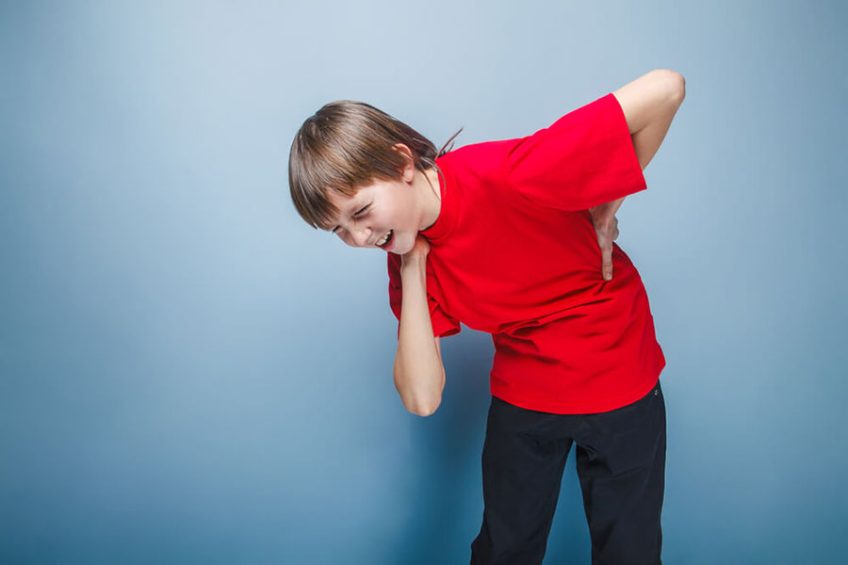While back pain is very common among adults, it is much less common in children. Therefore, any acute or chronic children’s back pain is taken much more seriously by the pediatrician.
Low back pain is most common for children, being the main reason for presenting to the doctor. Statistically, 20-36% of school-age children have episodes of low back pain.
Back pain at older children and adolescents is often “nonspecific back pain.”
At young children, the likelihood of them exaggerating the symptoms is very low, forcing the doctor to identify a possible “organic cause” that could be the source of back pain. However, it is important that all children with back pain to receive careful examination to avoid delaying the diagnosis of serious conditions.
CONTENT:
Causes of children’s back pain
Organic causes commonly associated with back pain include:
- Disc herniation
- Spondylolisthesis and spondylolysis
- Juvenile rheumatoid arthritis
- Infectious spondylitis (discitis, vertebral tuberculosis)
- Scheuermann’s kyphosis and severe kyphoscoliosis
- Idiopathic juvenile osteoporosis
- Tumor vertebrae (osteoid osteoma, osteoblastoma, eosinophilic granuloma, aneurysmal bone cyst, Ewing’s sarcoma, osteogenic osteosarcoma)
- Intramedullary tumors (astrocytoma and ependymoma)
- Acute lymphocytic leukemia
- Spinal metastases in the thoracic spine frequently from a neuroblastoma or a Wilms tumor
Symptoms of children’s back pain
In most cases, the signs and symptoms go away on their own in a short period of time. If any of the following signs or symptoms are accompanied by back pain, you should see your doctor:
- Weight loss
- Rising body temperature (fever)
- Inflammation (swelling) on the back
- Legs pain
- Pain that reaches below the knee
- A recent injury, blow or trauma to the back
- Urinary incontinence
- Difficulty urinating
- Fecal incontinence – you lose control of your gut
- Numbness around the genitals
- Numbness around the anus
- Numbness around the buttocks
Treatment of children’s back pain
Treatment for back pain generally depends on whether the pain is acute or chronic. Surgery is recommended only if there are organic causes of back pain, or nerve damage or changes in the bone structure of the vertebrae.
Remedies for relieving mild or short-term back pain
Muscle pain is a relatively common cause of back pain in a teenage athlete. Treatment includes discontinuation of physical activity, initially the application of ice and later local heat and non-steroidal anti-inflammatory drugs (nurofen or naproxen), which reduce inflammation, allowing better mobility of the spine.
Paracetamol (acetaminophen) is also a drug commonly used to reduce and treat back pain. These can be combined with codeine (opiate analgesic) and muscle relaxants, muscle relaxants that relax the muscles.
Topically applied gels or sprays that locally create the sensation of heat or cold can also relieve pain.
Muscle pain usually improves quickly in a few weeks. If the pain persists, an X-ray will be taken to rule out other potential causes, such as spondylolysis and spondylolisthesis.
In acute spondylolysis (pars interarticularis fracture), orthotic treatment with a thoracolombosacral orthosis can alleviate symptoms and help heal the fracture. Surgery is indicated only if the pain persists and does not improve after conservative treatment.
In spondylolisthesis, depending on the degree of slipping of the L5 vertebra in relation to the S1 vertebra, orthotic treatment or surgical treatment is indicated.
In disc herniation, most patients can be initially treated conservatively with restriction of physical activity, oral administration of anti-inflammatory drugs and corticosteroids, and physical therapy. Prolonged conservative treatment of a herniated disc may be associated with persistent pain, and if the adolescent or child does not respond to this therapeutic approach, pain relief can only be achieved by surgical removal of the disc (discectomy).
Back pain in Scheuermann’s kyphosis is usually located at the apex of the kyphosis and is usually aggravated by physical activity, prolonged standing or sitting. Often, the pain is not severe and is not associated with neurological signs.
Most patients are treated by medical gymnastics with spine extension exercises to tone the back extensors mm associated with correcting spinal deformity with a corset. Severe kyphotic deformities greater than 70º, accompanied by persistent pain are an indication for surgical treatment.


